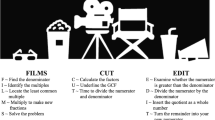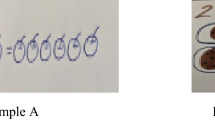Abstract
This study examined the effects of an academic music intervention on conceptual understanding of music notation, fraction symbols, fraction size, and equivalency of third graders from a multicultural, mixed socio-economic public school setting. Students (N = 67) were assigned by class to their general education mathematics program or to receive academic music instruction two times/week, 45 min/session, for 6 weeks. Academic music students used their conceptual understanding of music and fraction concepts to inform their solutions to fraction computation problems. Linear regression and t tests revealed statistically significant differences between experimental and comparison students’ music and fraction concepts, and fraction computation at posttest with large effect sizes. Students who came to instruction with less fraction knowledge responded well to instruction and produced posttest scores similar to their higher achieving peers.








Similar content being viewed by others
Notes
The Kodaly method originated in Hungary and stresses that music instruction should begin at an early age when children naturally love music and are freely able to absorb the inherent rhythm and timing. The Kodaly method incorporates a rhythm syllables system in which note values are assigned specific syllables, which literally express their durations. For example, quarter notes are expressed by the syllable “ta” while eighth note pairs are expressed using the naturally shorter syllables “ti-ti.” Larger note values are expressed by extending ta to become ta-a for the half note and ta-a-a-a for the whole note (see Wheeler, 1985).
References
Abrahamson, D. (2009). Embodied design: Constructing means for constructing meaning. Educational Studies in Mathematics, 70, 27–47. doi:10.1007/s10649-008-9137-1.
Arzarello, F., & Paola, D. (2007) Semiotic games: The role of the teacher. In J. Woo, H. Lew, K. Park, & D. Seo (Eds.). In Proceedings of the 31st conference of the International Group for the Psychology of Mathematics Education, 2, 17–24. Seoul: PME
Arzarello, F., Paola, D., Robuti, O., & Sabena, C. (2009). Gestures as semiotic resources in the mathematics classroom. Educational Studies in Mathematics, 70, 97–109. doi:10.1007/s10649-008-9163-z.
Arzarello, F., & Robuti, O. (2004). Approaching functions through motion experiments. Educational Studies in Mathematics, 57, 305–308.
Ashcraft, M. H., & Krause, J. A. (2007). Working memory, math performance, and math anxiety. Psychonomic Bulletin and Review, 14(2), 243–248.
Basurto, I. (1999). Conditions of reading comprehension which facilitate word problems for second language learners. Reading Improvement, 36, 143–148.
Behr, M. J., Lesh, R., Post, T. R., & Silver, E. A. (1983). Rational number concepts. In R. Lesh & M. Landau (Eds.), Acquisition of mathematics concepts and procedures (pp. 91–126). New York, NY: Academic Press.
Behr, M. J., Wachsmuth, I., Post, T. R., & Lesh, R. (1984). Order and equivalence of rational numbers: A clinical teaching experiment. Journal for Research in Mathematics Education, 15, 323–341. doi:10.2307/748423.
Brigham, J. F., Wilson, R., Jones, E., & Moisio, M. (1996). Best Practices: Teaching decimals, fractions, and percents to students with learning disabilities. LD Forum, 21, 10–15. Available from http://www.cldinternational.org/PDF/Initiatives/MathSeries/brigham.pdf. Accessed 11 August 2011.
Bright, G., Behr, M., Post, T., & Wachsmuth, I. (1988). Identifying fractions on number lines. Journal for Research in Mathematics Education, 19(3), 215–232. doi:10.2307/749066.
Bruner, J. S. (1977). The process of education. Cambridge, MA: Harvard University Press.
Butler, F. M., Miller, S. P., Crehan, K., Babbitt, B., & Pierce, T. (2003). Fraction instruction for students with mathematics disabilities: Comparing two teaching sequences. Learning Disabilities Research and Practice, 18, 99–111. doi:10.1111/1540-5826.00066.
California Department of Education (1999). Mathematics content standards for California public school: Kindergarten through grade twelve. Available from http://www.cde.ca.gov/be/st/ss/. Accessed 8 January 2012.
Center on Education Policy (2005). NCLB Policy Brief 3: Is NCLB Narrowing the Curriculum? Available from www.ctredpol.org/nclb/NCLBPolicyBriefs2005/CEPPB3web.pdf. Accessed 8 January 2008.
Chandler, D. (1994). Semiotics for beginners. Available from http://www.aber.ac.uk/media/Documents/S4B. Accessed 11 August 2011.
Cobb, P. (2000). From representations to symbolizing: Introductory comments on semiotics and mathematical learning. In P. Cobb, E. Yackel, & K. McClain (Eds.), Symbolizing and communicating in mathematics classrooms: Perspectives on discourse, tools, and instructional design (pp. 17–36). Mahwah, NJ: Lawrence Erlbaum Associates.
Cook, T. D., & Campbell, D. T. (1979). Quasi-experimentation. Design and analysis issues for field settings. Chicago, IL: Rand McNally.
Cramer, K. A., Post, T. R., & delMas, R. C. (2002). Initial fraction learning by fourth- and fifth-grade students: A comparison of the effects of using commercial curricula with the effects of using the rational number project curriculum. Journal for Research in Mathematics Education, 33, 111–145. doi:10.2307/749646.
David, J. H. (1995). The mathematics of music. Available from http://jackhdavid.thehouseofdavid.com/papers/math.html. Accessed 6 January 2012.
Ediger, M. (1999). Psychology foundations in teaching mathematics. (ERIC Document Reproduction Service No. ED431606). Accessed 14 July 2009 from ERIC database.
Empson, S. B. (2003). Low-performing students and teaching fractions for understanding: An interactional analysis. Journal for Research in Mathematics Education, 34(4), 305–343. doi:10.2307/30034786.
Foster, S. L., & Mash, E. J. (1999). Assessing social validity in clinical treatment research: Issues and procedures. Journal of Consulting and Clinical Psychology, 67, 308–319. doi:10.1037/0022-006X.67.3.308.
Frykholm, J. A. (2004). Teachers' tolerance for discomfort: Implications for curriculum reform in mathematics education. Journal of Curriculum and Supervision, 19(2), 125–149.
Furner, J. M., & Berman, B. T. (2004). Building math confidence for a high-tech world. Academic Exchange Quarterly, 8(2), 214–220.
Gault, B. (2005). Music learning through all channels: Combining aural, visual, and kinesthetic strategies to develop musical understanding. General Music Today, 19(1), 7–9. doi:10.1177/10483713050190010103.
Hiebert, J. (1989). The struggle to link written symbols with understandings: An update. Arithmetic Teacher, 36, 38–44.
Hiebert, J., Wearne, D., & Taber, S. (1991). Fourth graders gradual construction of decimal fractions during instruction using different physical representations. The Elementary School Journal, 91, 321–341. doi:10.1086/461658.
Hurwitz, I., Wolff, P. H., Bortnick, B. D., & Kokas, K. (1975). Nonmusical effects of the Kodaly music curriculum in primary grade children. Journal of Learning Disabilities, 8(3), 167–174. doi:10.1177/002221947500800310.
Maccini, P., & Gagnon, J. C. (2002). Perceptions and application of NCTM standards by special and general education teachers. Exceptional Children, 68, 325–345.
Mack, N. K. (1990). Long-term effects of building on informal knowledge in a complex content domain: The case of multiplication of fractions. The Journal of Mathematical Behavior, 19, 307–332. doi:10.1016/S0732-3123(00)00050-X.
Mack, N. K. (1995). Confounding whole-number and fraction concepts when building on informal knowledge. Journal for Research in Mathematics Education, 26, 422–441. doi:10.2307/749431.
Mazzocco, M. M. M., & Devlin, K. T. (2008). Parts and ‘holes’: Gaps in rational number sense among children with vs. without mathematical learning disabilities. Developmental Science, 11(5), 681–691. doi:10.1111/j.1467-7687.2008.00717.x.
McLaughlin, M. W., Shepard, L. A., & O’Day, J. A. (1995). Improving education through standards-based reform: A report by the National Academy of Education panel on standards-based education reform. Stanford, CA: Stanford University, National Academy of Education.
Menken, K. (2006). Teaching to the test: How No Child Left Behind impacts language policy, curriculum, and instruction for English Language Learners. Bilingual Research Journal, 30, 521–546.
Miller, S. P., & Hudson, P. J. (2007). Using evidence-based practices to build mathematics competence related to conceptual, procedural, and declarative knowledge. Learning Disabilities Research and Practice, 22, 47–57. doi:10.1111/j.1540-5826.2007.00230.x.
Miura, I. T., Okamoto, Y., Vlahovic-Stetic, V., Kim, C. C., & Han, J. H. (1999). Language supports for children’s understanding of numerical fractions: Cross-national comparisons. Journal of Experimental Child Psychology, 74, 356–365. doi:10.1006/jecp.1999.2519.
Moss, J., & Case, R. (1999). Developing children’s understanding of the rational numbers: A new experimental curriculum. Journal for Research in Mathematics Education, 30, 122–147. doi:10.2307/749607.
Music for All (2005). Music Advocacy. Retrieved August 10, 2010, from http://www.musicforall.org/who-we-are/advocacy
National Council of Teachers of Mathematics. (2000). Principles and standards for school mathematics. Reston, VA: NCTM.
National Research Council. (2001). Adding it up: Helping children learn mathematics. In J. Kilpatrick, J. Swafford, & B. Findell (Eds.), Mathematics Learning Study Committee, Center for Education, Division of Behavioral and Social Sciences and Education. Washington, DC: National Academy Press.
Newton, K. J. (2008). An extensive analysis of preservice elementary teachers’ knowledge of fractions. American Educational Research Journal, 45(4), 1080–1111. doi:10.3102/0002831208320851.
Ni, Y. (2001). Semantic domains of rational numbers and the acquisition of fraction equivalence. Contemporary Educational Psychology, 26, 400–417. doi:10.1006/ceps.2000.1072.
Niemi, D. (1996). Assessing conceptual understanding in mathematics: Representations, problem solutions, justification, and explanations. The Journal of Educational Research, 89(6), 351–363.
No Child Left Behind Act of 2001. 20 U.S.C. § 6310 et seq. (Reauthorization of the Elementary and Secondary Education Act).
Paik, J. H., & Mix, K. S. (2003). U.S. and Korean children’s comprehension of fraction names: A reexamination of cross-national differences. Child Development, 74, 144–154. doi:10.1111/1467-8624.t01-1-00526.
Post, T. R., Behr, M. J., & Lesh, R. (1986). Research-based observations about children’s learning of rational number concepts. Focus on Learning Problems in Mathematics, 8(1), 39–48.
Presmeg, N. (2006). Semiotics and the “connections” standard: Significance of semiotics for teachers of mathematics. Educational Studies in Mathematics, 61, 163–182. doi:10.1007/s10649-006-3365-z.
Radford, L. (2003). Gestures, speech and the sprouting of signs. Mathematical Thinking and Learning, 5(1), 37–70. doi:10.1207/S15327833MTL0501_02.
Radford, L., Bardini, C., & Sabena, C. (2007). Perceiving the general: The multi-semiotic dimension of students' algebraic activity. Journal for Research in Mathematics Education, 28, 507–530.
Radford, L., Edwards, S., & Arzarello, F. (2009). Introduction: Beyond words. Educational Studies in Mathematics, 70, 91–95.
Radford, L., Schubring, G., & Seeger, F. (2011). Signifying and meaning-making in mathematical thinking, teaching, and learning. Educational Studies in Mathematics, 77, 149–156.
Rasmussen, C., Nemirovsky, R., Olszewski, J., Dost, K., & Johnson, J. L. (2004). PME special issue: Bodily activity and imagination in mathematics learning. Educational Studies in Mathematics, 57, 303–321.
Scarlato, M. C., & Burr, W. A. (2002). Teaching fractions to middle school students. Journal of Direct Instruction, 2, 23–38.
Schnepp, M., & Chazan, D. (2004). Incorporating experiences of motion into a calculus classroom. Educational Studies in Mathematics, 57, 309–313.
Shields, D. J. (2005). Teachers have the power to alleviate math anxiety. Academic Exchange Quarterly, 9(3), 326–330.
Sood, S., & Jitendra, A. K. (2007). A comparative analysis of number sense instruction in first grade traditional and reform-based mathematics textbooks. Journal of Special Education, 41(3), 145–157. doi:10.1177/00224669070410030101.
Vygotsky, L. (1978). Interaction between learning and development. In M. Cole, V. John Steiner, S. Scribner, & E. Souberman (Eds.), Mind in society: The development of higher psychological processes (pp. 79–91). Cambridge, MA: Harvard University Press.
Wheeler, L. (1985). Orff and Kodaly: Adapted for the elementary school (3rd ed.). Dubuque, IA: Wm. C. Brown.
Woodward, J., Baxter, J., & Robinson, R. (1999). Rules and reasons: Decimal instructions for academically low achieving students. Learning Disabilities Research and Practice, 14, 15–24.
Yoshida, H., & Sawano, K. (2002). Overcoming cognitive obstacles in learning fractions: Equal-partitioning and equal-whole. Japanese Psychological Research, 44(4), 183–195. doi:10.1111/1468-5884.00021.
Yoshida, H., & Shinmachi, Y. (1999). The influence of instructional intervention on children’s understanding of fractions. Japanese Psychological Research, 41(4), 218–228. doi:10.1111/1468-5884.00122.
Young-Loveridge, J., Taylor, M., Hawera, N., & Sharma, S. (2007). Year 7-8 students’ solution strategies for a task involving addition of unlike fractions. In Findings from the New Zealand numeracy development project 2006. Wellington, New Zealand: Ministry of Education.
Author information
Authors and Affiliations
Corresponding author
Rights and permissions
About this article
Cite this article
Courey, S.J., Balogh, E., Siker, J.R. et al. Academic music: music instruction to engage third-grade students in learning basic fraction concepts. Educ Stud Math 81, 251–278 (2012). https://doi.org/10.1007/s10649-012-9395-9
Published:
Issue Date:
DOI: https://doi.org/10.1007/s10649-012-9395-9




